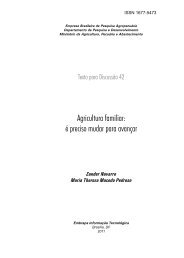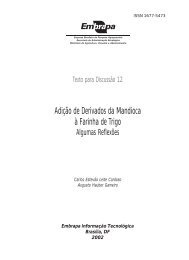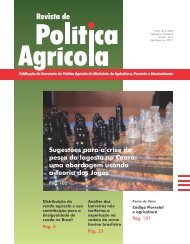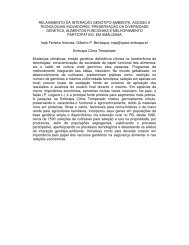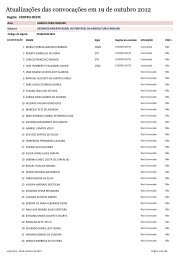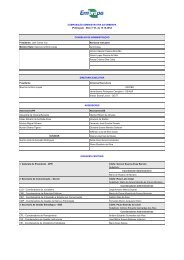Ministry of Agriculture, Livestock and Food Supply - Embrapa
Ministry of Agriculture, Livestock and Food Supply - Embrapa
Ministry of Agriculture, Livestock and Food Supply - Embrapa
You also want an ePaper? Increase the reach of your titles
YUMPU automatically turns print PDFs into web optimized ePapers that Google loves.
Table 11. Characteristics <strong>of</strong> oleaginous crops in Brazil.<br />
Species<br />
African palm<br />
Coconut<br />
Babassu<br />
Sunflower<br />
Colza/canola<br />
Castor beans<br />
Peanut<br />
Soybean<br />
Cotton<br />
Oil origin<br />
Nut<br />
Fruit<br />
Nut<br />
Grain<br />
Grain<br />
Grain<br />
Grain<br />
Grain<br />
Grain<br />
Oil contents<br />
(%)<br />
22.0<br />
55.0 – 60.0<br />
66.0<br />
38.0 – 48.0<br />
40.0 – 48.0<br />
45.0 – 50.0<br />
40.0 – 43.0<br />
18.0<br />
15.0<br />
Source: NOGEUIRA, L. A. H. et al. Agência Nacional de Energia Elétrica. Adapted by DPA/Mapa.<br />
Studies carried out by four ministries – Agrarian Development;<br />
<strong>Agriculture</strong>, <strong>Livestock</strong> <strong>and</strong> <strong>Supply</strong>; National Integration; <strong>and</strong> Cities - show that<br />
for each 1% share <strong>of</strong> the biodiesel market derived from family agriculture it<br />
would be possible to generate approximately 45,000 jobs in the hinterl<strong>and</strong>s,<br />
at an approximate cost <strong>of</strong> R$ 4.900,00 each (HOLANDA, 2004). Approximately<br />
180,000 new jobs would be created assuming that each job in the rural areas<br />
generates three jobs in the urban areas. Finally, it should also be emphasized<br />
that industrial agriculture employs, on average, one worker for every 100<br />
hectares farmed. In family agriculture each worker farms 10 hectares.<br />
Almost 220-million reais (R$) per year are necessary for every 1% share in<br />
the biodiesel market, with yearly gross revenues <strong>of</strong> approximately R$ 470 millions.<br />
Every real invested in family agriculture yields R$ 2,13 more in the annual gross<br />
income. So that the family income would double if family agriculture participated<br />
in the biodiesel market.<br />
As regards the paths used to produce biodiesel in the Northeast Region<br />
<strong>and</strong> in the State <strong>of</strong> Minas Gerais, the products <strong>of</strong> choice would be methyl alcohol<br />
<strong>and</strong> castor oil. In the Center-South, the preferred product would be ethyl alcohol,<br />
mainly because its ready availability.<br />
In Brazil most <strong>of</strong> the biodiesel will be produced by transesterification<br />
(80%) for a large wholesale market addressing the mixture <strong>of</strong> biodiesel into<br />
petrodiesel, large fleet consumption <strong>and</strong> consumers interested in increasing<br />
the proportion <strong>of</strong> biodiesel mixed to petrodiesel. The remainder would be<br />
obtained by cracking in small remote communities.<br />
84<br />
Harvest<br />
(months/year)<br />
12<br />
12<br />
12<br />
3<br />
3<br />
3<br />
3<br />
3<br />
3<br />
Yield (tons <strong>of</strong><br />
oil/hectare<br />
3.0 – 6.0<br />
1.3 – 1.9<br />
0.1 – 0.3<br />
0.5 – 1.9<br />
0.5 – 0.9<br />
0.5 – 0.9<br />
0.6 – 0.8<br />
0.2 – 0.4<br />
0.1 – 0.2




